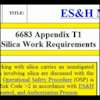| ES&H Manual | |||||
| Chapter 6683 Silica Safety Program | |||||
Jefferson Lab has determined that working with silica carries an unmitigated Risk Code >2. At a minimum all tasks involving silica are discussed with the supervisor prior to commencement. An Operational Safety Procedure (OSP) is written for any work considered to be Risk Code >2 in accordance with ES&H Manual Chapter 3210 Work Planning, Control, and Authorization Process. Purpose Silica, when dispersed in air (dust particulates), poses a serious health hazard. This program addresses techniques for mitigating silica exposure for activities that occurs at Jefferson Lab including, but not limited to grinding, cutting, mixing, and drilling of concrete, brick, grout, and rock; miscellaneous sand and gravel operations; and removal of furnace insulation[1].
ScopeThis program satisfies applicable federal, state, and local requirements as outlined in ES&H Manual Chapter 2410 Appendix T1 Hazard Issues List. For the purposes of this program "silica" refers to respirable crystalline, quartz, cristobalite, and tridymite. Contact Industrial Hygiene for guidance when using other forms. This program applies to activities at Jefferson Lab that would commonly occur during day-to-day operations. This program complies with requirements of 29 CFR 1910.1053 and 29 CFR 1926.1153. Table 1: Required Silica Safety Training by Job Classification
Depending on the complexity of the activity (i.e. indoors, confined space), Industrial Hygiene may require "hold points" to verify control adequacy of engineered, administrative controls, and/or Personal Protective Equipment (PPE). Involve Jefferson Lab Industrial Hygiene in work planning activities. |
|||||
Appendices: T1 Silica Work Requirements
ES&H Manual Chapter 6683 Appendix T1 Silica Work Requirements provides Jefferson Lab's minimum requirements when working with silica including: planning, actual activities, and clean-up.
|
Responsibilities:
Management authority may be delegated to a task qualified Jefferson Lab employee at the discretion of the responsible manager. Trained Worker
Supervisor/Technical Representative (TR)/Sponsor
TR also
Industrial Hygiene
Silica Subject Matter Expert
|
||||
Document Control:
|
|||||
|
This document is controlled as an on-line file. It may be printed but the print copy is not a controlled document. It is the user's responsibility to ensure that the document is the same revision as the current on line file. . |
|||||


